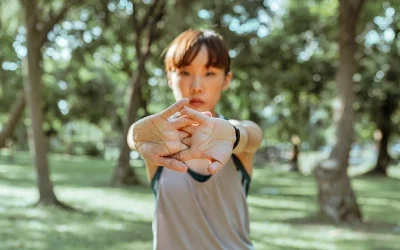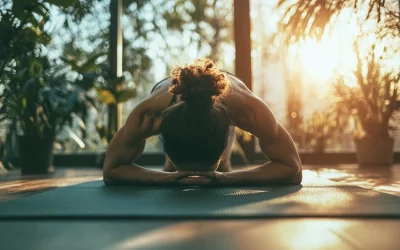Many of us can remember a time where a parent or a family member was on our case about improving our posture. Maybe they verbally nagged you not to slouch or they would poke your spine every time they saw you hunched over. As a child, you didn’t want to listen to them because proper posture was hard work, but now… Now you’re realizing why they were trying so hard to train you to have good posture back then.
The nice thing is that it is never too late to work on improving your posture. It might not be as easy as you age, but it is possible to stand tall, regardless of how old you are.
Why posture matters.
Your body is designed to function best when it is in alignment.
While this may seem intuitive, it’s easy to rest in a misaligned posture- such as putting all your weight on one leg or looking down at your phone. A few hours in a funny position won’t severely affect you in the long run, as our bodies are designed to move, but think of the last time you slept wrong. Chances are that you felt exhausted for at least that day and you constantly noticed various aches and pains.
Your body settles into what is repeated.
Some people have laugh lines by their eyes, others have frown lines by their mouths, and some have perpetual worry lines between their eyebrows. These are visible examples of your skin and muscles settling into a repeated pattern- and your posture does the same. If you are always sitting slouched over, then over time it may be hard to straighten up completely.
This is why you want to establish good body habits as soon as you possibly can, so that you don’t have to worry about being scrunched up and in pain when you’re older.
Athletes- you’ll have more power in your sport.
An easy example to visualize would be to think of a figure skater trying to do a fast twirl on the ice. If they were slouching, they would lose momentum and wouldn’t appear as refined.
Even in sports where you have to bend over, crouch, or squat to perform, notice how the best athletes still support the core of good posture. Regardless if they are playing tennis, sprinting, doing martial arts, or any other sport, notice how the top athletes stay mostly in alignment as they perform.
Musicians- you will be able to sing and play better.
When a pianist doesn’t have their wrists in an aligned, neutral position with their elbows, then they cannot play as efficiently, effectively, or as quickly as they may need. This misalignment can cause pain to radiate between the fingers and shoulders and may even cause long- term damage, due to the pressure put on joints in unnatural positions. By having the elbows rest naturally at about 90 degrees, with the wrists extended straight out from the arms, you will be able to optimize your playing ability and longevity.
Singers rely on good posture to be able to sing properly. By hunching over, you restrict the movement of your lungs, and you can compress your diaphragm. Regardless of if you’re trained or not, try this for yourself: Try singing any song while hunched over and curled up, then straighten your posture and sing again. Notice the difference in pitch control, power, and overall sound!
(Keep an eye out for any singing performance that requires the singer to be on the ground, either “collapsed” or on their knees. They’ll move their arms and legs to give the illusion of a distressed body posture, but their torso will stay strong and supported, at least while in song!)
You’ll breathe easier and stronger.
Much like how singers rely on good posture to produce good sound, you’ll notice that your breathing will become easier as you sit or stand up straight. This is because your lungs can freely expand in every possible direction- down, out to the sides, and even towards your spine. Your diaphragm can function without restraint and without any restrictions on where your breath can go, breathing will become easier.
Having a good posture will improve your confidence.
How you hold yourself informs how you perceive yourself and tells others what to think of you. When you curl in, hunch your shoulders, and cover your chest with your arms, it signals to your body that you are not safe and can activate fight or flight mode. At the very least, you will feel small and others will treat you as such.
By standing up straight and tall, you are letting the world know that you belong here, which improves how others perceive you and boosts your overall confidence levels.
Simple posture adjustments.
Proper posture is basically being able to imagine a straight line running down your body, with your neck held perpendicular to your shoulders, your spine is elongated and straight, and your feet in line with your hips.
You can do a simple wall check by standing with your heels 2-4 inches away from the wall. Your buttocks, shoulders, and head should gently press against the wall. Slide one of your hands into the curve of your lower back. If there is a significant amount of excess space between your back, your hand, and the wall, engage your core muscles to draw your spine back a little bit.
The nice thing is that even doing one or two of the suggestions below can make a small difference. As you continue doing them, they will eventually become habitual, which will gradually improve your posture.
Small ways to improve your posture.
- Keep your feet centered on the floor while sitting.
- Roll your shoulders back.
- Engage your core to support your spine.
- Don’t sit on anything in your back pockets. (Such as your phone or wallet- it puts strain on your spine.)
- Line your head up with your shoulders. Your neck should be straight, not jutting out.
- Stand with your feet hip-width apart, keeping your weight evenly distributed between the two.
- Check your sitting alignment to make sure that you have back and lumbar support, your arms are at 90 degrees, your wrists are resting neutrally (not bent up or down), and your computer monitor is at your eye level so you can look directly at it, not up or down.
- Implement proper lifting techniques, such as lifting from your knees, not your back, keeping heavy items near the middle of your body (not storing them up high or down low), and only lifting as much as you can safely carry.
Posture stretching exercises.
Back stretches.
- Plant your feet hip-width apart. Twist your upper body in both directions, then tilt it to both sides. For additional stretches, combine twisting and tilting.
- Arch your back, with your arms together above your head. Only do this stretch as far as you are comfortable and have something to hold onto if you need to.
- Do the classic cat and cow stretches. Get on your hands and knees, with your back flat. Gently push your chest to the floor, looking up to enhance the stretch. Then, transition so your back is curved towards the roof, tucking your chin to your chest.
Neck and shoulder stretch.
- Look up towards the roof then down at your belly. While in either of these positions look both right and left for additional stretches.
- Raise your arms to 90 degrees and gently press your forearms against both sides of a door frame until you feel a stretch.
- Clasp your hands together behind your back. Bend forward, keeping your back flat and allowing your arms to fall forward. Keep your knees loose and unlocked while in this stretch.
Hip stretches.
- Sit on the floor, with your knees bent and the bottoms of your feet pressed together. Gently push your knees towards the floor to your comfort level.
- Either laying flat on the floor or standing up (with support, if necessary) hug your knee to your chest. Repeat with the other leg.
- Stand, holding onto something for balance. Bend your leg and pull your ankle towards your bum. Repeat on the other side.
If you would like more targeted stretches, be sure to check out WeStretch’s customizable stretching routines. The Pain Relief & Rehab routines are great for focusing on a certain body part or joint and the Workplace Posture Improvement is great for stretching those muscles that are affected by sitting behind a desk every day!
Seek professional help.
Sometimes you’ll need external help to achieve your posture goals. Stretching is a great tool but you can maximize the benefits from it by pairing it with help from a professional.
A massage therapist can help you loosen tight muscles that are causing you pain or preventing you from reaching your full range of motion. A chiropractor can help you to get adjusted and back in alignment. Your physiotherapist can identify which areas to work on and create a treatment plan to improve your posture over time.
Note:
If you are actively trying to improve your posture and you either cannot or your back is causing you a significant amount of pain, it is best to get checked out by your doctor. You could have an underlying condition, such as osteoarthritis, a ruptured disk, or a muscle sprain.
Conclusion
Good posture can support you throughout your life, reducing back pain, and boosting your confidence levels. Start by knowing what proper posture looks and feels like for your body. Work on making small adjustments to strengthen your spine over time. Regular exercise and stretching help to improve back flexibility and the muscular strength needed to support good posture.
Any links included are for reference, additional information, or entertainment value only, without monetary compensation. Contact us on social media or at [email protected].
This article is not intended to act as or replace medical advice. Please talk to your healthcare practitioner if you have any concerns.
Written by Kayla Willsey






